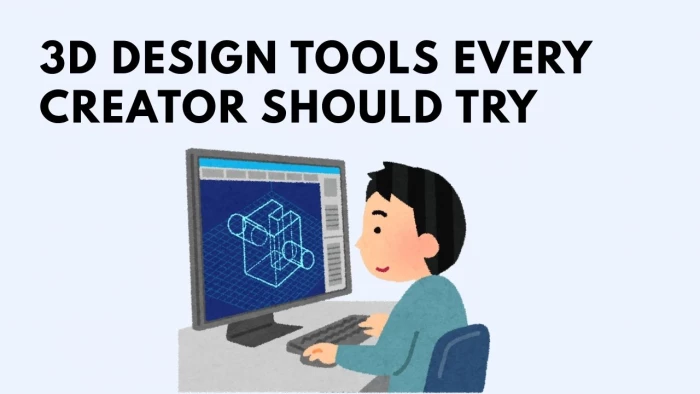

In the world of digital creativity, 3D design has become more than just a niche skill—it’s an essential medium for artists, marketers, game developers, architects, and content creators. With industries rapidly moving towards immersive experiences, augmented reality (AR), virtual reality (VR), and 3D product visualization, learning and experimenting with 3D tools is no longer optional for ambitious creators.
But here’s the challenge: with so many 3D design tools available, from free beginner-friendly apps to complex professional-grade software, how do you know where to start? Whether you’re a content creator testing product mockups, a designer dabbling in 3D printing, or a marketer looking to craft eye-catching campaigns, there’s a tool for you.
In this blog, we’ll explore the top 3D design tools every creator should try, covering their strengths, best use cases, learning curves, and why they stand out. By the end, you’ll have a clearer idea of which platform to experiment with depending on your goals.
Before we dive into the tools, let’s take a step back. Why should creators care about 3D design? Here are a few reasons:
Now, let’s get into the actual tools worth exploring.
Blender is the gold standard for free, open-source 3D design. It’s a professional-grade software loved by independent artists, hobbyists, and even major studios for its all-in-one capabilities—from modeling and sculpting to rendering, animation, and video editing.
Why Creators Should Try It:
Best For:
Learning Curve: Steep at first, but manageable with tutorials.
Maya is a heavyweight in the 3D world, widely used in film, animation, and video game production. If you’ve ever marveled at 3D effects in Hollywood movies, there’s a good chance Maya was involved.
Why Creators Should Try It:
Best For:
Learning Curve: Very steep—best for intermediate to advanced creators.
Cinema 4D is a favorite among motion graphics designers, particularly in advertising and broadcast media. Known for its user-friendly interface and powerful rendering engine, it’s often described as a more approachable alternative to Maya or Blender.
Why Creators Should Try It:
Best For:
Learning Curve: Moderate—easier for those already familiar with Adobe tools.
ZBrush is the tool of choice for digital sculpting. If you’ve ever seen highly detailed 3D character models in games or collectible figurines, chances are ZBrush was used.
Why Creators Should Try It:
Best For:
Learning Curve: Moderate to steep, depending on your familiarity with sculpting.
SketchUp is known for being one of the easiest tools to learn, making it perfect for beginners. It’s widely used in architecture, interior design, and product mockups, but creators across industries can use it for basic 3D concepts.
Why Creators Should Try It:
Best For:
Learning Curve: Easy—best entry point for beginners.
Owned by Autodesk, Tinkercad is a browser-based tool that makes 3D design accessible to complete beginners—even kids. Don’t be fooled, though: it’s also practical for quick prototypes and 3D printing models.
Why Creators Should Try It:
Best For:
Learning Curve: Very easy.
Houdini is a professional-grade tool famous for its procedural generation. This makes it a favorite in the movie and gaming industry, especially for creating complex simulations like fire, smoke, water, and explosions.
Why Creators Should Try It:
Best For:
Learning Curve: Steep, but incredibly powerful once mastered.
Unity is primarily a game development engine, but it also supports 3D design, simulation, and AR/VR projects. It’s a versatile tool for creators who want to step into interactive 3D content.
Why Creators Should Try It:
Best For:
Learning Curve: Moderate—lots of resources available.
Unreal Engine has gained huge popularity for cinematic-quality rendering. From blockbuster video games to architectural visualization, Unreal is pushing the boundaries of what real-time 3D graphics can do.
Why Creators Should Try It:
Best For:
Learning Curve: Moderate to steep.
Fusion 360 is Autodesk’s tool focused on engineering and product design. It’s especially popular among inventors, product developers, and engineers who need to turn 3D concepts into functional prototypes.
Why Creators Should Try It:
Best For:
Product designers, engineers, and 3D printing enthusiasts.
Learning Curve: Moderate—depends on technical background.
With so many options, choosing the right tool can feel overwhelming. Here are some quick guidelines:
Think about your goals—are you experimenting, creating content, or aiming for a professional career? Your choice will differ based on this.
The future of 3D design is being shaped by AI integration, cloud collaboration, and immersive experiences. Already, tools like Blender and Unreal Engine are experimenting with AI-assisted modeling and real-time rendering.
In the near future, we’ll likely see:
For creators, this means more opportunities, faster workflows, and fewer barriers to entry.
3D design is no longer a specialized skill reserved for experts—it’s becoming part of the everyday creator’s toolkit. Whether you’re a marketer looking to make eye-catching ads, a content creator experimenting with 3D thumbnails, or an aspiring game developer, the tools on this list provide endless opportunities to grow.
The key is to start small. Download one beginner-friendly tool, follow a few tutorials, and experiment. With time, you’ll build confidence and move on to more advanced platforms.
At the end of the day, 3D design isn’t just about software—it’s about creativity, problem-solving, and storytelling. The right tool is simply the bridge between your imagination and the final masterpiece.
Be the first to post comment!